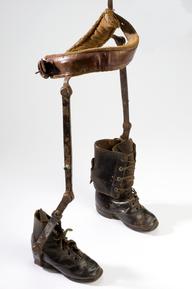

Artificial arms worn by Katrina Gardner as a teenager
- Made:
- 1975 in Kingston-Upon-Hull
Pair of artificial arms worn by Katrina Gardner as a teenager, living with limb difference caused by the compound thalidomide, made at the Artificial Limb Centre, Sykes Street, Hull, 1975
“I needed to feel normal and I wanted to wear clothes with long sleeves so I could fit in with everyone else and I wanted to look like everyone else too.” Katrina
After many fittings as a young child for carbon dioxide powered artificial arms, Katrina requested these arms as a teenager. Worn from the age of 13 until she was 17, they were made to look as lifelike as possible with textured skin and veins painted on. When Katrina started to learn to drive and going out with friends, she stopped wearing these limbs using other adaptations instead. These artificial limbs hold a range of memories for Katrina and her family. As a child, one of her daughters added the nail varnish to the fingers. Katrina is an artist, former Mouth and Foot Painting Association student and amateur archaeologist, mother to four children, step-mother to two more children and 10 grandchildren. She frequently speaks at schools about her experience.
Katrina’s limb difference is caused by the compound, thalidomide. Just as each person’s experience of living with thalidomide impairments is different, so is their experience with prosthetic or artificial limbs. This might be due to the attitudes of their families and medical professionals they met. Prosthetic or artificial limbs were in part meant to act as reparations for the impairments that thalidomide had caused. They were frequently used as a way of visually “normalising” the bodies of people living with thalidomide impairments. Many question who these supposed improvements were really meant to help. Some children underwent operations to make the prosthetic limbs fit better which could include amputations. Children had little input into these decisions and the trauma of some of these medical interventions is still felt today, both emotionally and physically.
Thalidomide was a compound found in drugs prescribed to people in the late 1950s and early 1960s. Although today it is associated primarily as a treatment for pregnancy related nausea, it was also prescribed to anyone experiencing symptoms of colds, flu, headaches, anxiety, and insomnia. Thalidomide causes nerve damage in the hands and feet of adults, but when taken in early pregnancy it causes impairments such as limb difference, sight loss, hearing loss, facial paralysis, and impact to internal organs. One tablet is enough to cause significant impairments. Researchers later identified that there was a link between the impairment a person is living with, and which day of the pregnancy thalidomide was taken. UK distributors withdrew the drug in 1961 and a government warning was issued in May 1962.
Details
- Category:
- Orthopaedics
- Object Number:
- 2023-560
- Materials:
- rubber
- Measurements:
-
overall: 200 mm x 700 mm x 500 mm,
- type:
- artificial arm




